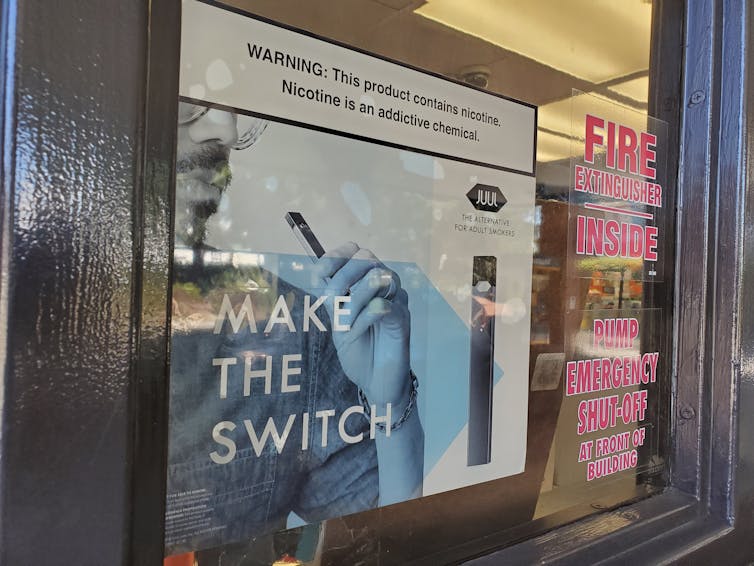Tue 15 August 2023:
Existing regulations have not managed to reduce the rising rates of youth vaping in Aotearoa New Zealand.
Both the latest NZ Health Survey and Snapshot Y10 survey reported high levels of daily vaping among young people aged 18 to 24 (23%) and 14 to 15 (10% overall, but more than 20% among rangatahi Māori). Other studies and reports from school principals confirm we need urgent action to address youth vaping.
But what measures should policymakers implement? To answer this question, we need to consider how vape marketing makes these products widely available, appealing, addictive and affordable.
We outline nine measures that would counter vape marketing and help reduce vaping prevalence among young people.
Making vapes harder to access
Aotearoa treats vaping products like consumer items. This approach means they are as ubiquitous as milk and essential household items.
The number of vape retailers has risen rapidly, with more than 1,100 R18 vape stores able to sell a full array of different flavours. A growing number of these “specialist” stores are located within dairies (small convenience stores), where young people will have potentially high exposure to vaping products.
"We do have a vaping epidemic amongst our youth and way too many vape stores, and now we have products with far too much nicotine in them." @AsthmaFndation chief executive Letitia Harding on the growing number of vape shops in New Zealand. https://t.co/PGRk2qr8BZ
— RNZ – Nine To Noon (@ninetonoon) October 27, 2022
Access to vaping products by young people could be reduced by:
1. removing vapes from generic outlets, such as dairies and service stations, and allowing only dedicated specialist vape stores to sell vaping products
2. setting proximity and density limits that prevent vape stores from trading near schools or proliferating within shopping areas.
Making vapes less appealing to young people
People who smoke should be supported to quit, and vaping is one of the tools to help them move away from smoking. While early vaping products replicated the appearance of cigarettes and offered a visual analogue of a smoked cigarette, more recent designs target a much broader market.
Vaping “pods” have high aesthetic appeal but remain easy to conceal – attributes young people value. Limited-life devices known as “disposables” combine these features with low prices (NZ$10 or less) and, as Health Minister Ayesha Verrall has noted, have become an “easy gateway product to vaping”.
While priced to appeal to young people, disposables offer less value to people who smoke, who typically require a product with a longer lifespan as they transition from smoking to vaping.
Unlike smoked-tobacco products, which cannot be displayed in stores, vaping products are on full display and often occupy large display units with high visibility behind cash registers.

Vaping can help people who smoke quit tobacco, but vape designers target a much broader market. Getty Images
Vaping products could be made less appealing to young people by:
3. ending sales of disposable vapes
4. disallowing vaping product displays within generic stores and ensuring vaping products sold in R18 specialist stores are visible only once people have entered the store
5. requiring all vaping products to use plain packaging, thus removing the colourful designs likely to appeal to young people
6. introducing and enforcing age validation measures on all product websites; current “tick box” systems enable people of all ages to access what should be R18 sites
7. regulating social media promotions and disallowing promotions such as free offers, competitions, “buy one get one free” and referral offers.
Making vapes less addictive and less affordable
Many e-liquids used in vapes have high nicotine concentrations; these make vaping highly addictive and mean young people may become dependent on nicotine quickly.
Vaping products could be made less addictive to young people by:
8. instating a maximum nicotine concentration, for example 20mg/ml, as permitted in the EU.
It is important not to impede switching among people who could potentially benefit by moving from smoking to exclusive vaping, but low-cost disposable products nevertheless need stronger regulation. Ending sales of disposable vapes would also reduce young people’s ability to afford vaping products.
It is crucial to develop a robust evaluation process to assess the effectiveness of new measures, particularly given evidence that vaping is imposing a greater burden on rangatahi Māori than other ethnic groups.
To address evidence of underage sales and findings that more than 50% of young people reported buying vaping products from dairies, we need greater monitoring and stronger penalties for stores found to have sold vaping products to minors.
Measures to assess new vaping product regulations should include:
9. increased surveillance (including studies exploring why young people vape, their perceptions of vaping, how they source vaping products and how vape use evolves) and compliance monitoring.
Youth vaping is a serious public health problem and we need comprehensive measures that control the marketing strategies used to target young people. Our rangatahi deserve no less.
Author:
![]()
Janet Hoek
Professor of Public Health, University of Otago
My first three degrees were in English Literature; I completed a Masterate exploring the use of irony in Beowulf, a very early Old English poem. I next worked in marketing, as a survey researcher, and undertook a PhD in survey research. I taught marketing for several years but became increasingly interested in public health and, when the opportunity to move disciplines arose, I relocated to the Department of Public Health. I co-direct a UOO research centre (ASPIRE 2025) and undertake work to support the Government’s smokefree 2025 goal.
______________________________________________________________
FOLLOW INDEPENDENT PRESS:
TWITTER (CLICK HERE)
https://twitter.com/IpIndependent
FACEBOOK (CLICK HERE)
https://web.facebook.com/ipindependent
Think your friends would be interested? Share this story!








